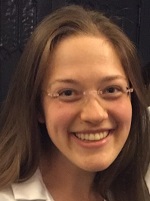Deborah D. Rupert
Education:
B.A., Psychology; Concentration, Neuroscience, Carleton College (2011)
M.S., Human Nutrition, Columbia University (2012)
M.A., Biotechnology, Columbia University (2015)
Ph.D., Neuroscience, Stony Brook University (2022)
Current Position:
9th Year MSTP
4th Year Medical Student
Advisor:
Stephen Shea, PhD
Graduate Program:
Neuroscience
Thesis Title:
Auditory Cortex Inhibitory Interneurons and Their Plasticity in the Context of Methyl CpG Binding Protein 2 Mutation
Thesis Abstract:
Rett Syndrome (RTT) is a pervasive, neurodevelopmental disorder previously classified as a syndromic type of Autism Spectrum Disorders (ASDs). Unlike ASDs, RTT is monogenic- caused by loss of function mutations in the X-linked gene Methyl CpG Binding Protein 2 (MeCP2). MeCP2 codes for the protein by the same name, a ubiquitously expressed transcription factor with a known role in the plasticity of mature synapses. As MeCP2 is an X-linked allele, its mutation results in a mosaic pattern of cells expressing functional MeCP2 protein and those with absent expression. Whether certain cell types within that mosaic contribute more or less to phenotypic characteristics (i.e., aberrant sensory processing) is unknown. Our team previously reported that adult female mice that are mosaic for Mecp2 mutation demonstrate impaired auditory processing. Namely, in mosaic RTT animal subjects, single-unit fast-spiking auditory cortex (ACtx) cells demonstrate aberrantly strong response to ultrasonic vocalization (USV) playbacks, and upregulation of anti-plasticity molecular markers by inhibitory ACtx cells. We suspect these functional and molecular differences underlie the inability of Mecp2 mutants to respond to pup USVs behaviorally. Here we dissect out the various cell types of the ACtx and their relative dependence on MeCP2 in the context of auditory processing. Our goal was to determine the contribution of cell-type specific Mecp2 mutation to disruption of ACtx circuitry and plasticity that degrade social vocal perception. We hypothesize that aberrant audition may result from the relative dependence of ACtx fast-spiking inhibition interneurons on MeCP2. We report the consequences of cell-type restricted MeCP2 knockdown on that USV-dependent behavior, single-unit in vivo neural circuit activity of excitatory and inhibitory populations, and calcium imaging of ACtx parvalbumin-positive cells. Our findings expand our understanding of ACtx plasticity in neurotypically developing animals and cell-type specific contributions to that plasticity.
Awards:
Stony Brook University Medical Scientist Training Program Community Engagement Award (2022)
American Medical Association (AMA) Research Challenge Semifinalist (2022)
Cold Spring Harbor Laboratory Women in Science and Engineering Mentorship Award (2022)
Stony Brook Three Minute Thesis Competition Finalist (2022)
Autism Speaks Royal Arch Mason Pre-doctoral Research Fellow (2018-2021)
New York University Winthrop Student-run Health Clinic Community Service Award (2020)
Publications:
Rupert DD, Pagliaro A, Choe J, Shea SD (2023). Selective deletion of Methyl CpG binding protein 2 from parvalbumin interneurons in the auditory cortex delays the onset of maternal retrieval in mice. J Neurosci. PMID: 36778467; doi: 10.1101/2023.01.30.526321.
Rupert DD, Shea SD (2022). Parvalbumin-Positive Interneurons Regulate Cortical Sensory Plasticity in Adulthood and Development Through Shared Mechanisms. Front Neural Circuits. doi: 10.3389/fncir.2022.886629. PMID: 35601529; PMCID: PMC9120417.
Rupert D, Shah K, Chen B, O’Glasser, A, Schiml, M, Jain, S, and Chino, F (2022). Sex and Location Differences in Verification Status of Physician-Held Social Media Platform Accounts. JAMA Netw Open. 5(8):e2225671. DOI:10.1001/jamanetworkopen.2022.2567.
Rupert DD, Alvarez GV, Burdge EJ, Nahvi RJ, Schell SM, Faustino FL (2022). Student-Run Free Clinics Stand at a Critical Junction Between Undergraduate Medical Education, Clinical Care, and Advocacy. Acad Med. 10.1097/ACM.0000000000004542. doi:10.1097/ACM.0000000000004542
Rupert, D, Nowlan, A, Tam, O, and Hammell, M (2020). Ten simple rules for running a successful womenin-STEM organization on an academic campus. PLOS Computational Biology. DOI: .10.1371/journal.
Pillai, R, Malhotra, A, Rupert, D, Weschler, B, Williams, J, Zhang, M, Yang, J, Mann, J, Oquendo, M, Parsey, R, and DeLorenzo, C (2017). Relations between cortical thickness, serotonin 1A receptor binding, and structural connectivity: A multimodal imaging study. Journal of Human Brain Mapping. DOI:10.1002/hbm.23903.
Neiworth, J, London, J, Flynn, M, Rupert, D, Alldritt, O. and Hyde, C (2017). Artificial grammar learning in tamarins depends on the stimulus context. Journal of Comparative Psychology. 131(2): 128–138. doi:10.1037/com0000066.
Shair, H, Rupert, D, Rosko, L, Hofer, M, Myers, M, and Welch, M, (2015). Effects of maternal deprivation and the duration of reunion time on rat pup ultrasonic vocalization responses to isolation: possible implications for human infant studies. Developmental Psychobiology. 57(1), 63-72. DOI:10.1002/dev.21258.
Neiworth, J, Whillock, K, Kim, S. H, Greenberg, J, Jones, K, Patel, A, Steefel-Moore, D, Shaw, A, Rupert, D, Gauer, J, and Kudura, A, (2014). Gestalt principle use in college students, children with autism, toddlers (Homo sapiens), and cotton top tamarins (Saguinus oedipus). Journal of Comparative Psychology. 128(2), 188-198. DOI:10.1037/a0034840.

